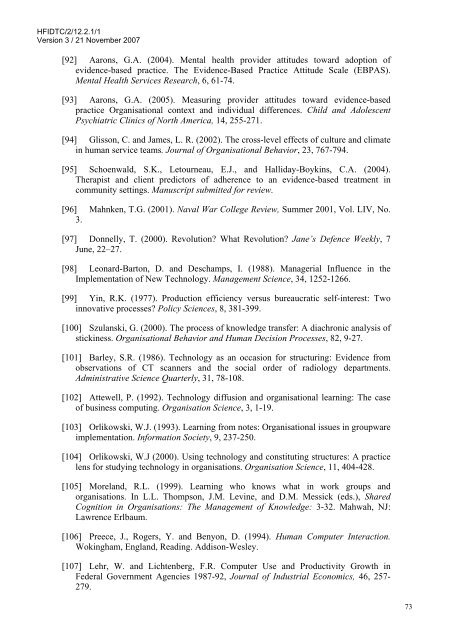The Impact of Technology Insertion on Organisations
The Impact of Technology Insertion on Organisations
The Impact of Technology Insertion on Organisations
Create successful ePaper yourself
Turn your PDF publications into a flip-book with our unique Google optimized e-Paper software.
HFIDTC/2/12.2.1/1<br />
Versi<strong>on</strong> 3 / 21 November 2007<br />
[92] Aar<strong>on</strong>s, G.A. (2004). Mental health provider attitudes toward adopti<strong>on</strong> <str<strong>on</strong>g>of</str<strong>on</strong>g><br />
evidence-based practice. <str<strong>on</strong>g>The</str<strong>on</strong>g> Evidence-Based Practice Attitude Scale (EBPAS).<br />
Mental Health Services Research, 6, 61-74.<br />
[93] Aar<strong>on</strong>s, G.A. (2005). Measuring provider attitudes toward evidence-based<br />
practice Organisati<strong>on</strong>al c<strong>on</strong>text and individual differences. Child and Adolescent<br />
Psychiatric Clinics <str<strong>on</strong>g>of</str<strong>on</strong>g> North America, 14, 255-271.<br />
[94] Gliss<strong>on</strong>, C. and James, L. R. (2002). <str<strong>on</strong>g>The</str<strong>on</strong>g> cross-level effects <str<strong>on</strong>g>of</str<strong>on</strong>g> culture and climate<br />
in human service teams. Journal <str<strong>on</strong>g>of</str<strong>on</strong>g> Organisati<strong>on</strong>al Behavior, 23, 767-794.<br />
[95] Schoenwald, S.K., Letourneau, E.J., and Halliday-Boykins, C.A. (2004).<br />
<str<strong>on</strong>g>The</str<strong>on</strong>g>rapist and client predictors <str<strong>on</strong>g>of</str<strong>on</strong>g> adherence to an evidence-based treatment in<br />
community settings. Manuscript submitted for review.<br />
[96] Mahnken, T.G. (2001). Naval War College Review, Summer 2001, Vol. LIV, No.<br />
3.<br />
[97] D<strong>on</strong>nelly, T. (2000). Revoluti<strong>on</strong>? What Revoluti<strong>on</strong>? Jane’s Defence Weekly, 7<br />
June, 22–27.<br />
[98] Le<strong>on</strong>ard-Bart<strong>on</strong>, D. and Deschamps, I. (1988). Managerial Influence in the<br />
Implementati<strong>on</strong> <str<strong>on</strong>g>of</str<strong>on</strong>g> New <str<strong>on</strong>g>Technology</str<strong>on</strong>g>. Management Science, 34, 1252-1266.<br />
[99] Yin, R.K. (1977). Producti<strong>on</strong> efficiency versus bureaucratic self-interest: Two<br />
innovative processes? Policy Sciences, 8, 381-399.<br />
[100] Szulanski, G. (2000). <str<strong>on</strong>g>The</str<strong>on</strong>g> process <str<strong>on</strong>g>of</str<strong>on</strong>g> knowledge transfer: A diachr<strong>on</strong>ic analysis <str<strong>on</strong>g>of</str<strong>on</strong>g><br />
stickiness. Organisati<strong>on</strong>al Behavior and Human Decisi<strong>on</strong> Processes, 82, 9-27.<br />
[101] Barley, S.R. (1986). <str<strong>on</strong>g>Technology</str<strong>on</strong>g> as an occasi<strong>on</strong> for structuring: Evidence from<br />
observati<strong>on</strong>s <str<strong>on</strong>g>of</str<strong>on</strong>g> CT scanners and the social order <str<strong>on</strong>g>of</str<strong>on</strong>g> radiology departments.<br />
Administrative Science Quarterly, 31, 78-108.<br />
[102] Attewell, P. (1992). <str<strong>on</strong>g>Technology</str<strong>on</strong>g> diffusi<strong>on</strong> and organisati<strong>on</strong>al learning: <str<strong>on</strong>g>The</str<strong>on</strong>g> case<br />
<str<strong>on</strong>g>of</str<strong>on</strong>g> business computing. Organisati<strong>on</strong> Science, 3, 1-19.<br />
[103] Orlikowski, W.J. (1993). Learning from notes: Organisati<strong>on</strong>al issues in groupware<br />
implementati<strong>on</strong>. Informati<strong>on</strong> Society, 9, 237-250.<br />
[104] Orlikowski, W.J (2000). Using technology and c<strong>on</strong>stituting structures: A practice<br />
lens for studying technology in organisati<strong>on</strong>s. Organisati<strong>on</strong> Science, 11, 404-428.<br />
[105] Moreland, R.L. (1999). Learning who knows what in work groups and<br />
organisati<strong>on</strong>s. In L.L. Thomps<strong>on</strong>, J.M. Levine, and D.M. Messick (eds.), Shared<br />
Cogniti<strong>on</strong> in Organisati<strong>on</strong>s: <str<strong>on</strong>g>The</str<strong>on</strong>g> Management <str<strong>on</strong>g>of</str<strong>on</strong>g> Knowledge: 3-32. Mahwah, NJ:<br />
Lawrence Erlbaum.<br />
[106] Preece, J., Rogers, Y. and Beny<strong>on</strong>, D. (1994). Human Computer Interacti<strong>on</strong>.<br />
Wokingham, England, Reading. Addis<strong>on</strong>-Wesley.<br />
[107] Lehr, W. and Lichtenberg, F.R. Computer Use and Productivity Growth in<br />
Federal Government Agencies 1987-92, Journal <str<strong>on</strong>g>of</str<strong>on</strong>g> Industrial Ec<strong>on</strong>omics, 46, 257-<br />
279.<br />
73

















